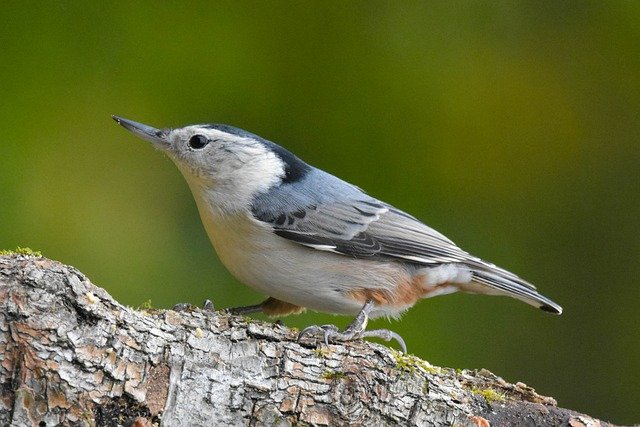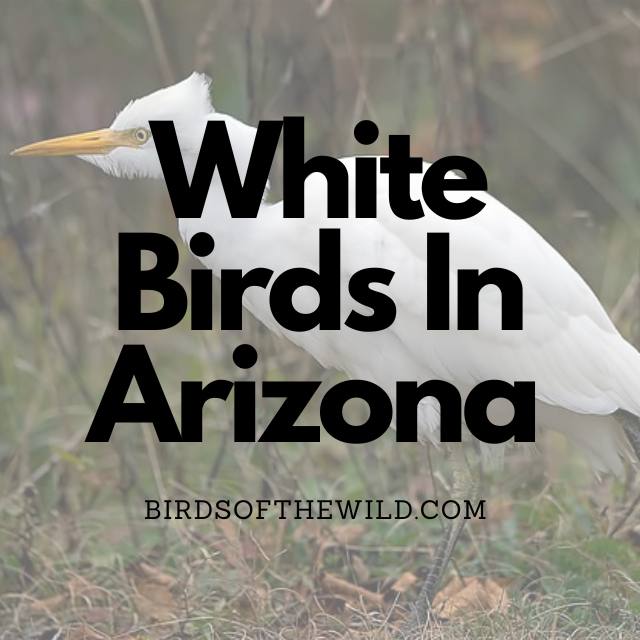Although not entirely common, you can find the occasional white bird in Arizona of you know where to look. In this article I’ll be going over 5 unique ones that can be found within the state so continue reading for more information on them
- Snowy Egret
- White Breasted Nuthatch
- American Herring Gull
- American White Pelican
- Cattle Egret
5 White Birds In Arizona
1. Snowy Egret (Egretta Thula)

- Size: 56 – 66cm
- Weight: 350 – 390 grams
- Wingspan: 95 – 105cm
You can spot snowy egrets within Arizona when they are going through their season of breeding, which typically involves the spring and summer months.
Snowy egrets as their name would suggest are snow white birds with a long neck, black beak, black legs whilst also having a relatively large frame. Besides their sexual organs the only differentiating factors between males and females are that the males are slightly larger.
You’ll find these egrets by mudflats, beaches, and wetlands, but you can also see them forage in wet agricultural fields and along the edges of rivers and lakes.
Snowy egrets eat a variety of foods from fish, insects, crustaceans which includes crabs, crayfish, frogs, snakes, snails, worms, lizards, rodents and more.
These egrets are known to live for around 5 – 6 years in the wild and upwards of 16 years in captivity.
2. White Breasted Nuthatch (Sitta Carolinensis)

- Size: 13 – 14cm
- Weight: 18 – 30 grams
- Wingspan: 20 – 27cm
White breasted nuthatches can be found in almost all of Arizona, besides its southwest regions, on a year round basis.
These white breasted nuthatches are recognised by their gray back, wings and the upper head with white breast feathers. Females look the same as the males.
As for where you would find these white breasted nuthatches, it would be around mature woods and woodland edges, where they’re most commonly located by deciduous stands that have maple, hickory, basswood, oak and are even found in some coniferous forests.
They mostly consume nuts, seeds and insects, which can include hazelnuts, sunflower seeds and suet.
As for how long white breasted nuthatches live in the wild, it tends to be around 2 years with the longest lifespan recorded around 12 years.
3. American Herring Gull (Larus Smithsonianus)

- Size: 60 – 67cm
- Weight: 1 – 1.5kg
- Wingspan: 120 – 160cm
These herring gulls will typically be making their migratory passage through Arizona, towards a location that suits their breeding environments or periods when they aren’t breeding.
American herring gulls are recognised by their gray wings, black tail feather, white feathers in the remainder of their body, yellow beak and reddish/orange legs. The females are typically a dirty light brown/gray color where it appears as if they’ve had mud sprayed across their feathers.
You’ll find these herring gulls around coasts and inland around rubbish tips, fields, large reservoirs and lakes.
In regards to what these gulls eat, it tends to be carrion, offal, seeds, fruits, young birds, eggs, small mammals, insects and fish.
American herring gulls are know to live for around 30 years on average, with the longest recorded hitting 49 years of age.
4. American White Pelican (Pelecanus Erythrorhynchos)

- Size: 130 – 160cm
- Weight: 6 – 6.5kg
- Wingspan: 260 – 290cm
American white pelicans can be found in southwest Arizona when they aren’t breeding. As for the remainder of the state, they will typically migrate through those regions towards a location that suits them more.
These pelicans can be recognised by their mostly white plumage and extremely large bills. Females look vey similar to the males.
You’ll often spot these birds around lakes and rivers.
As for what they eat, it includes mostly fish of the rough kind that humans don’t typically capture, smaller amphibians and crayfish.
Wild American white pelicans are known to live for around 16 year in the wild whilst captive ones are known to be around the 30 – 35 year range.
5. Cattle Egret (Bubulcus Ibis)

- Size: 45 – 50cm
- Weight: 270 – 512 grams
- Wingspan: 82 – 95cm
You’ll be able to find cattle egrets around the western border of Arizona on year round basis. They’ll only spend time around the southeast part of the state when breeding and typically use the remainder to migrate to either one of these regions.
Cattle egrets are recognised by their mostly white plumages, with hints of orange around the head and chest, coupled with 2 yellow legs and a yellow beak. Females look very similar to the males but, are slightly smaller and have smaller breeding plumes than the opposite gender.
As for where you’ll be able to find these egrets, they will often reside by open habitats, wetlands, grasslands and woodlands generally following cattle around.
Cattle egrets generally tend to eat insects, worms, reptiles, frogs and mice.
In regards to lifespan, a cattle egret is known to live for around 10 years in the wild.
Amhil Khan, a dedicated nature enthusiast and the founder of BirdsOfTheWild.com, is a passionate advocate for the captivating world of avian wonders. With a deep-seated curiosity about the intricate lives of birds, Amhil’s journey began as a fascination and has evolved into a mission to inspire others to appreciate and protect these magnificent creatures.
Amhil’s love for birds led to the creation of Birds of the Wild, a platform where his expertise in ornithology, coupled with his captivating storytelling, provides readers with an immersive and educational experience. Through his lens and words, he captures the essence of birds in their natural habitats, offering a glimpse into their behaviors, migrations, and the ecosystems they inhabit.

